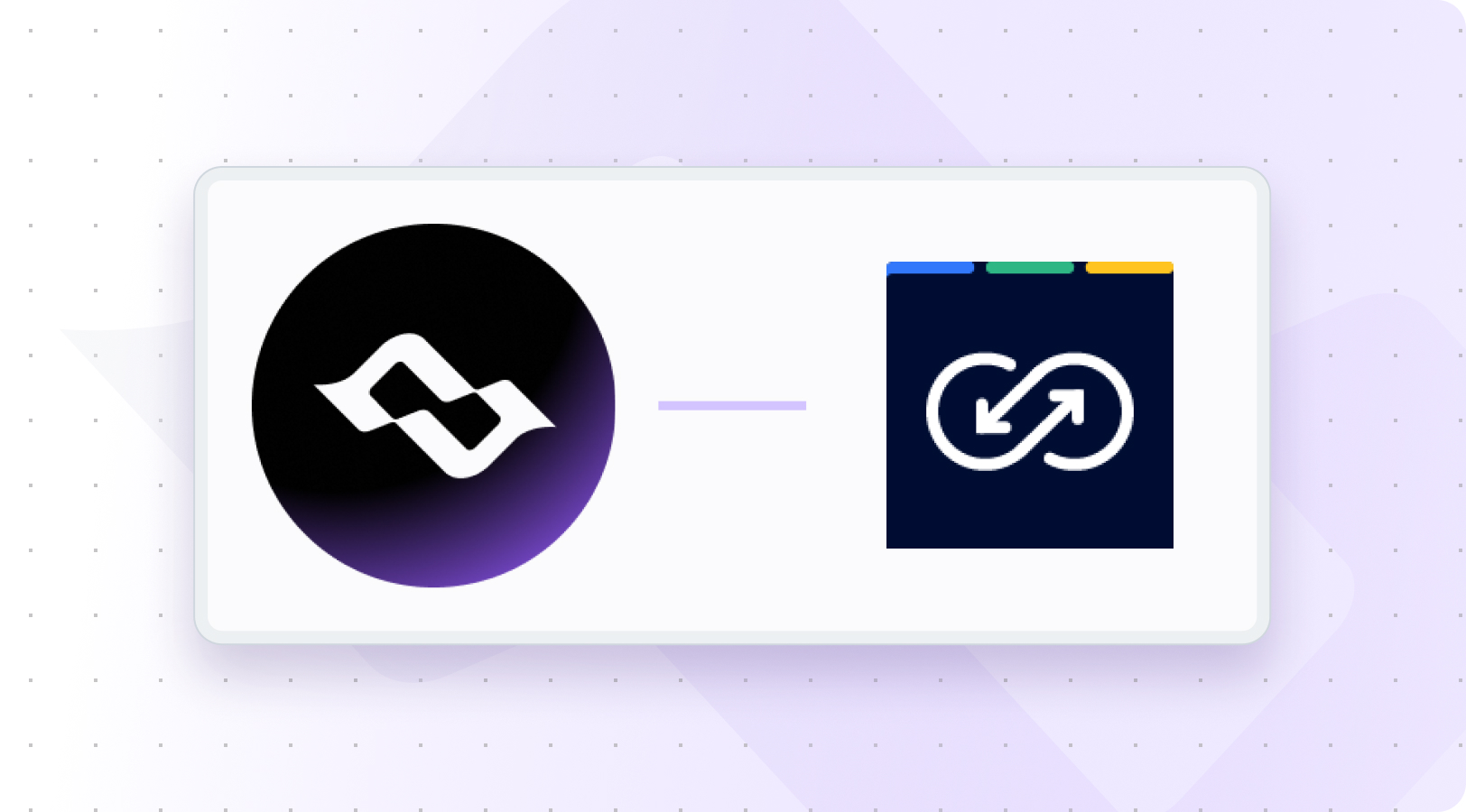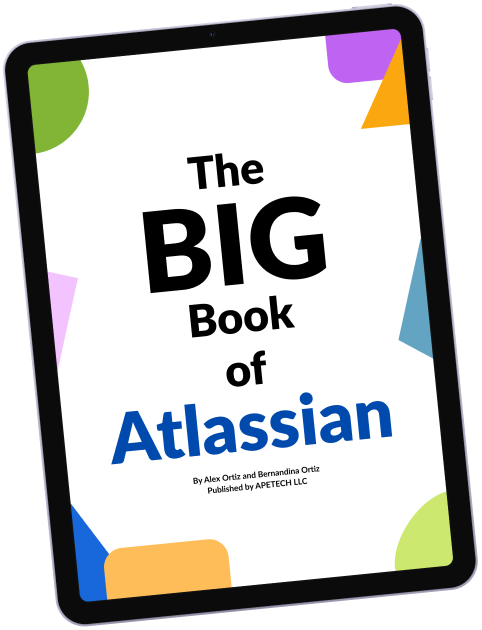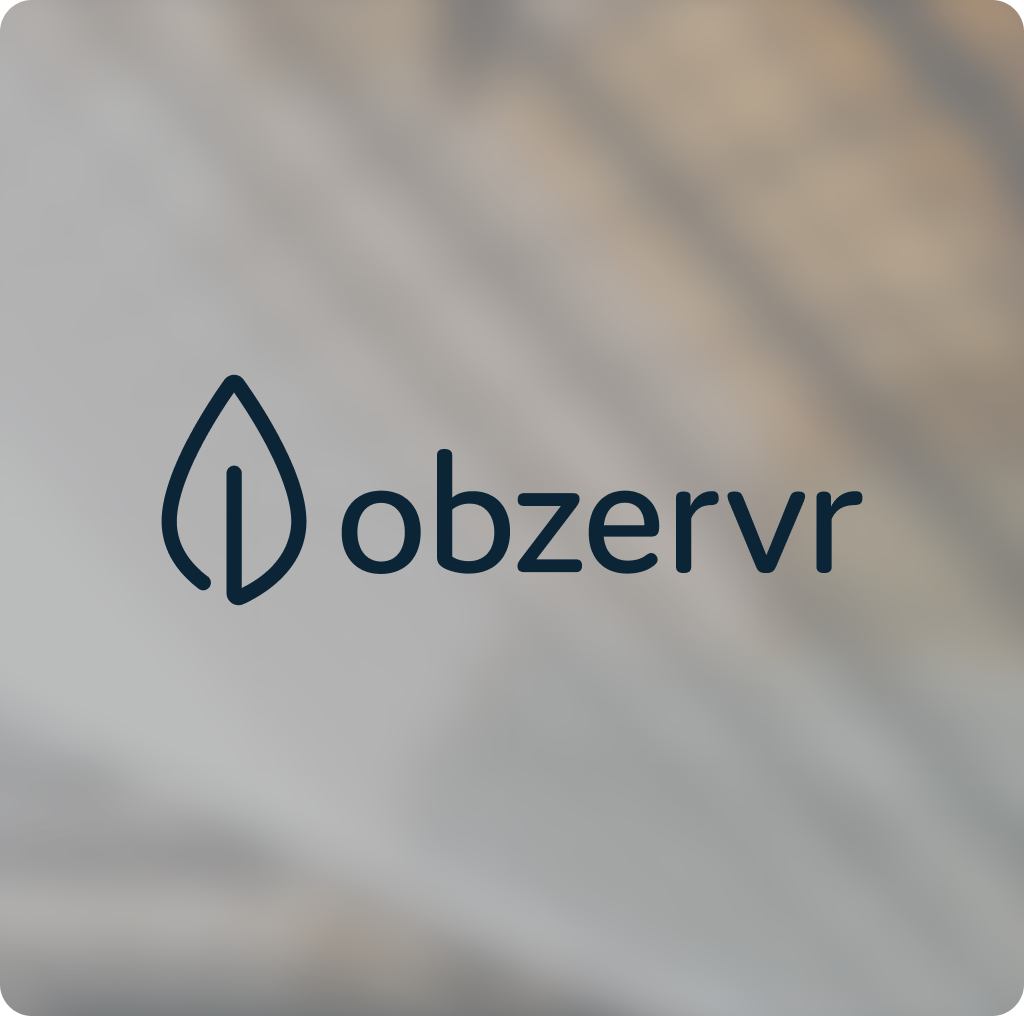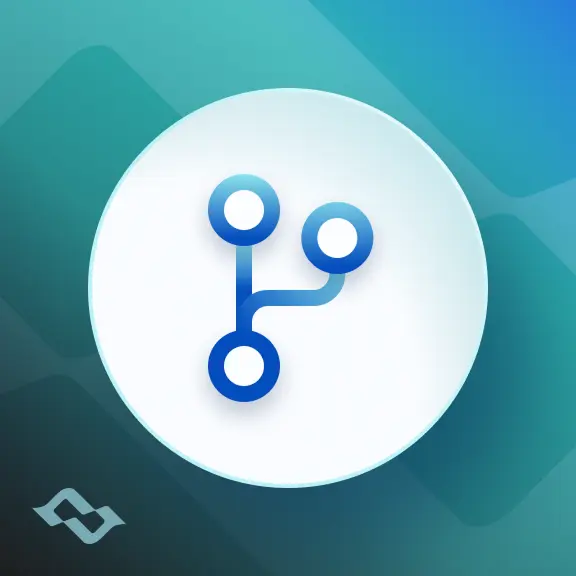Introduction: Jira-to-Jira Integration Explained
As more companies adopt Atlassian’s Jira and Jira Service Management, the demand for seamless integration between different Jira instances is skyrocketing. Whether it’s connecting two partner companies, a Managed Service Provider needing to sync with 10+ clients, or an internal sync between Jira Software and Jira Service Management, the need is clear: manual copying and pasting between platforms is time-consuming and prone to errors.
That’s where tools like Backbone and Getint come in. They automate the flow of data, eliminating the need for manual updates and reducing the risk of data loss or sync delays. Plus, with no-code solutions gaining popularity, even non-technical teams can set up these integrations without outside help.
In this post, we’ll dive deep into the key differences between Backbone and Getint, covering everything from features and ease of use to pricing and deployment. By the end, you’ll know exactly which tool is right for your Jira-to-Jira integration needs.
Executive Summary: Key Differences and Overview
What is Getint?
Founded in 2020 in Gdańsk, Poland, Getint was built with a singular focus: transforming how teams manage cross-platform integrations. With a no-code interface and powerful customization options like scripting, Getint delivers a flexible solution for companies looking to sync Jira with tools like Asana, Azure DevOps, and ServiceNow.
Today, Getint serves over 4,000 companies and 541,000 users worldwide, consistently growing 100% year over year. With a 3.82/4 rating on the Atlassian Marketplace, Getint is one of the fastest-growing integration platforms available, known for its advanced customization options and user-friendly interface.
What is Backbone?
Backbone Issue Sync, developed by K15t (an Atlassian Platinum Partner), is an integration tool designed exclusively for Jira-to-Jira syncs. It’s been around for over a decade and has 2,800+ installations on the Atlassian Marketplace with a 3.4/4 rating.
While it supports Jira Cloud, Server, and Data Center, Backbone’s primary focus is straightforward Jira-to-Jira integrations, without the broader flexibility Getint offers for syncing across multiple platforms.
Key Differences at a Glance
• Platform Support: Getint syncs Jira with multiple platforms (Asana, Azure DevOps, ServiceNow), while Backbone is limited to Jira-to-Jira integrations.
• Flexibility: Getint offers both no-code and scripting options for complex workflows. Backbone provides basic mapping and lacks advanced customization options.
• User Interface: Getint features a modern, intuitive UI designed for quick setup, while Backbone’s older interface feels outdated, especially for more complex integrations.
• Licensing: Both platforms offer remote licenses, but Getint allows this for any Jira type (Cloud, Server, Data Center). Backbone’s remote licenses are restricted to Jira Server or Data Center instances.
Deployment Options: Cloud, On-Premise, and More
• Backbone: Available only as a Jira application, either in the Cloud or behind the firewall for Jira Server/Data Center.
• Getint: Offers more flexibility with SaaS, on-premise deployment (fully behind the firewall), and Jira Cloud and Data Center applications. This makes it an ideal solution for enterprises with stringent security requirements.
Supported Platforms: What Tools Can You Sync?
When choosing an integration platform, it’s crucial to know what tools it supports. Both Backbone and Getint allow Jira-to-Jira integrations, but Getint offers far more versatility when it comes to connecting with other popular collaboration tools.
Backbone: Limited to Jira
Backbone is a specialized tool designed exclusively for Jira-to-Jira integrations. Whether you’re syncing Jira Software, Jira Service Management, or Jira Data Center, Backbone supports seamless data flow between Jira instances. However, this focus on Jira means that if your organization uses other platforms, Backbone won’t be able to support them.
Getint: Multi-Platform Flexibility
Getint, on the other hand, is built for versatility. While it excels at Jira-to-Jira integrations, it also supports a wide range of collaboration tools, including:
• Jira Software & Jira Service Management
• Azure DevOps
• ServiceNow
• Salesforce
• Monday.com
• Asana
• And many more

For teams that need to sync multiple tools across departments or with external partners, Getint provides the flexibility and reach that Backbone can’t match. Even better, Getint offers custom development options for companies with unique integration needs that aren’t available out of the box.
User Experience: Which Platform is Easier?
A tool is only as good as its usability. If it’s difficult to navigate or configure, even the most powerful platform becomes a headache. So how do Backbone and Getint compare when it comes to user experience?
Backbone: Old-School Simplicity
Backbone has a straightforward, no-frills interface. If you’re dealing with basic Jira-to-Jira syncs, it’s functional and easy enough to use. However, its design feels outdated, reminiscent of early 2000s applications.
Once you dive into more complex tasks—like setting up a status sync or configuring advanced mappings—you’ll find yourself digging through menus and instructions. Backbone also requires two separate installations (one on each Jira instance), which means two UIs, two payments, and often, two people coordinating to set things up.
Users who switched from Backbone to Getint often mention the frustration of managing these dual setups, calling it an outdated approach to modern integration tools.

Getint: Modern and Intuitive
Getint balances ease of use with flexibility. Its sleek, modern UI allows you to set up integrations in minutes with the QuickBuild feature, which is simple enough for non-technical users. For more advanced workflows, Getint provides custom scripts and manual configurations, all accessible from a single interface.
Reviews consistently highlight Getint’s user-friendly experience. Whether you’re managing simple syncs or complex cross-platform integrations, Getint’s design guides you through the process without confusion. With only one app and UI to manage, you can get up and running faster—no need for dual installations or multiple approvals.

Bottom Line:
Backbone works well for basic, Jira-only syncs but feels clunky for anything more complex. Getint, with its modern UI and streamlined setup, offers a smoother, more flexible experience for both basic and advanced integrations.
Installation & Configuration Guide: Step-by-Step Setup
Setting up Jira-to-Jira integrations can vary in complexity based on the tool you use. Below, we guide you through the complete installation and configuration processes for Backbone and Getint, focusing on the key differences in setup.
Backbone: Installation & Configuration
Backbone requires a few more steps to get everything up and running. Here’s a step-by-step breakdown:
Step 1:
Install the Backbone app from the Atlassian Marketplace on the first Jira instance.
Step 2:
Install the Backbone app on the second Jira instance (installation is required on both instances).
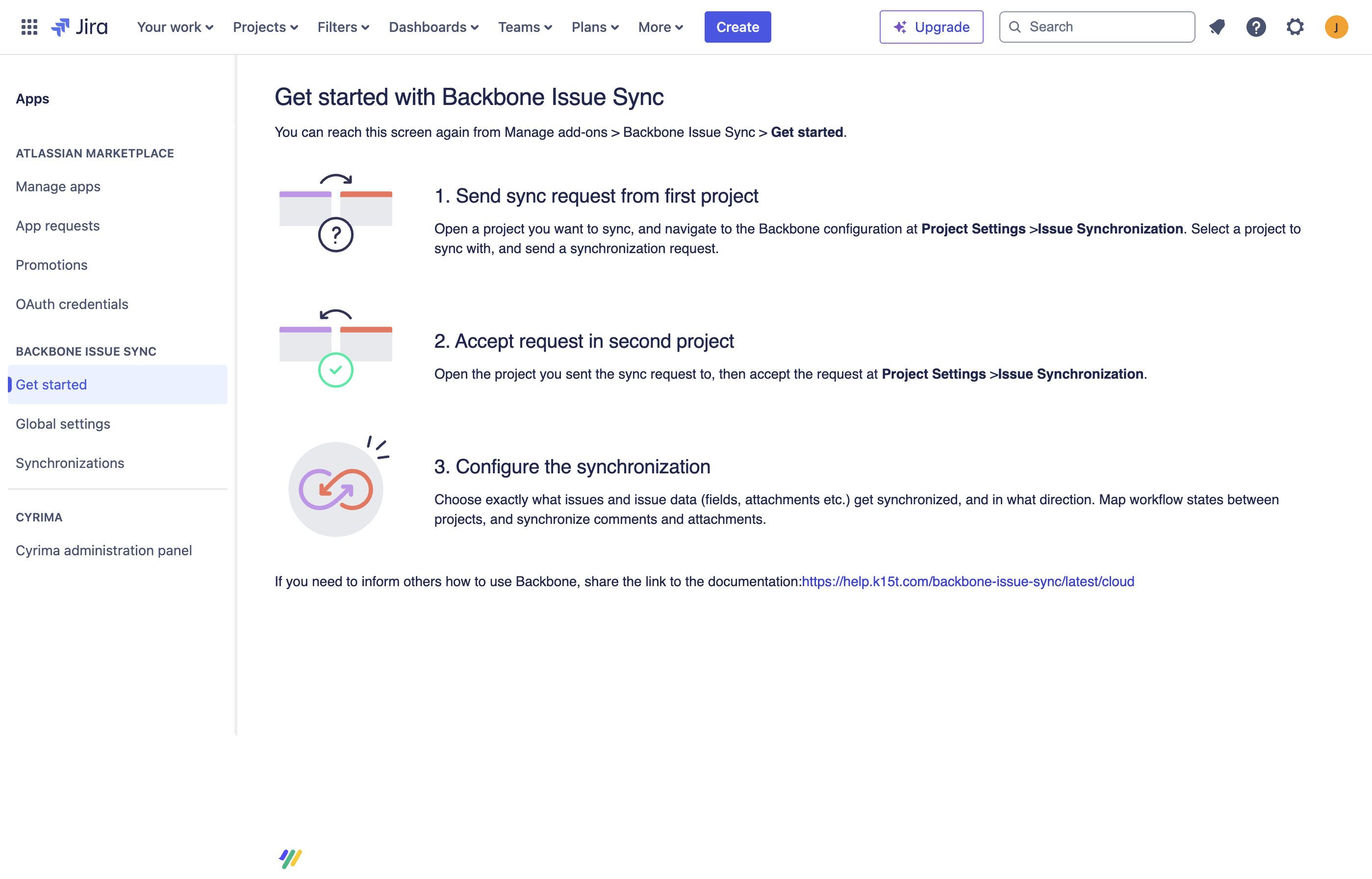
Step 3:
Start the synchronization process by selecting if you’d like to integrate with another project on the same instance, a different Jira Cloud instance, or a Jira Data Center instance. For this guide, we’ll choose Integrating with Another Jira Cloud.
Step 4:
Select the project from your first Jira instance that you wish to sync, and provide the URL of the second Jira instance.
Step 5:
Choose how updates will be handled:
• Immediate sync
• Or require manual review on the second instance.
Step 6:
Provide a name and description for your integration to help keep things organized.
Step 7:
Send the synchronization request to the second Jira instance.
Step 8:
Wait for an admin to accept the request on the second Jira instance, or accept it yourself if you have admin rights.
Step 9:
Review the connection details and confirm permissions between both instances.
Step 10:
Head to the Configuration tab, then click Edit to start customizing your setup.
Step 11:
Map your issue types. You’ll have two options:
• Simple Mappings for syncing identical issue types (e.g., Task to Task),
• Advanced Mappings to sync different issue types (e.g., Bug to Epic).
For this guide, we’ll go with Simple Mappings.
Step 12:
Next, configure the Field Mappings. Choose between:
• Simple Mappings for fields of the same type (e.g., Summary to Summary),
• Advanced Mappings for fields with different configurations.
We’ll stick with Simple Mappings here.

Step 13:
Save the integration and start the sync. Test the connection by creating a task in one Jira instance and confirming it syncs properly with the other.
Getint: Installation & Configuration
With Getint, the process is more streamlined and efficient. Here are the steps:
Step 1:
Install the Getint app from the Atlassian Marketplace or create an account onapp.getint.io.
Step 2:
Go to Workflows and click Create Integration.
Step 3:
Connect your first Jira instance by entering the URL and Personal Access Token.
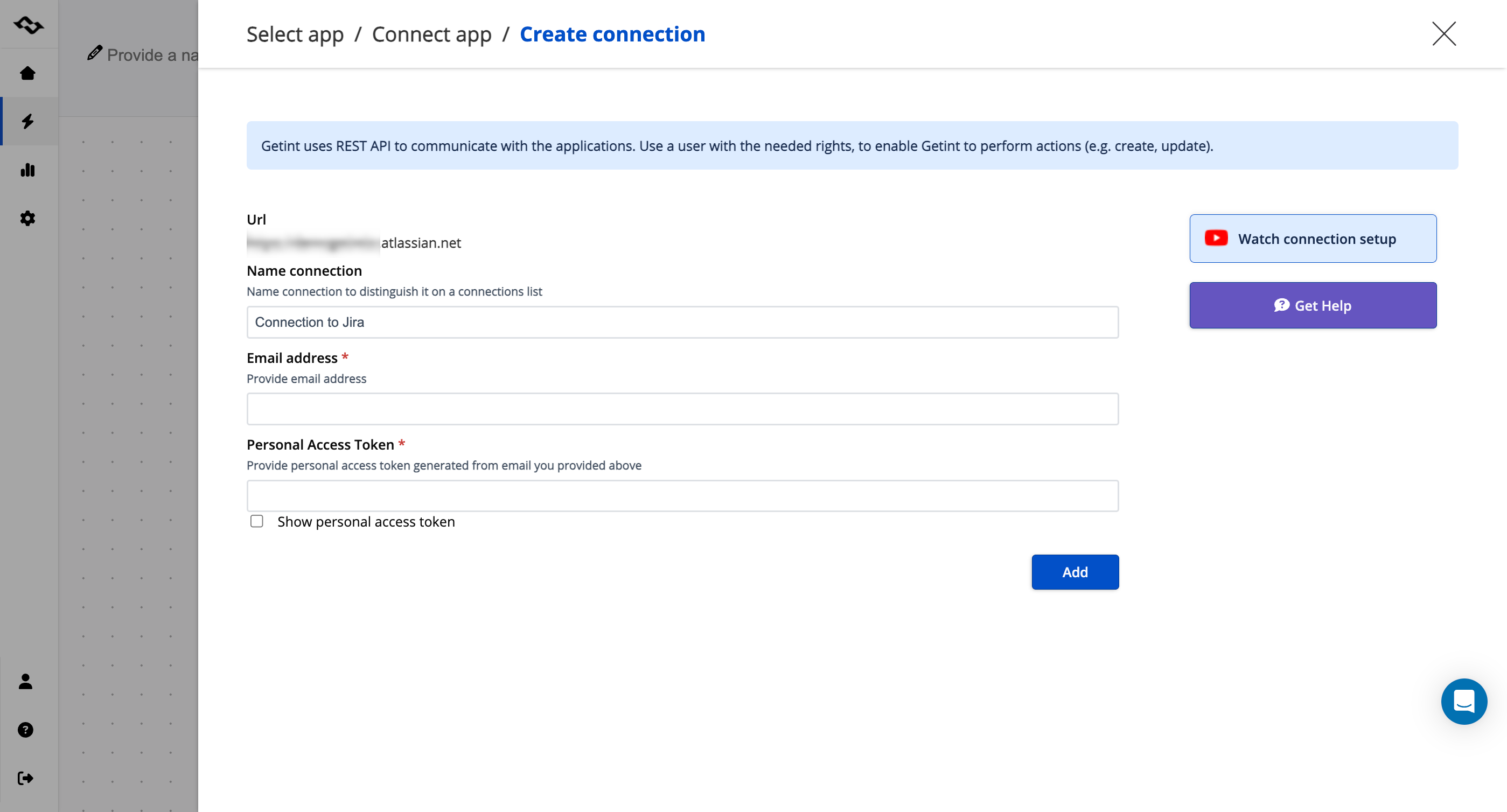
Step 4:
Select the project you want to integrate from the preloaded list—there’s no need to manually input project names or URLs.
Step 5:
Establish a connection with your second Jira instance, again using the URL and Personal Access Token. During the trial, you won’t need to install the app on the second Jira instance. Afterward, you can install it or get a remote license.
Step 6:
Select the project from the preloaded list for the second Jira instance.
Step 7:
Use QuickBuild to automatically map issue types, fields, and values. Adjust these mappings if necessary, all from a single interface.
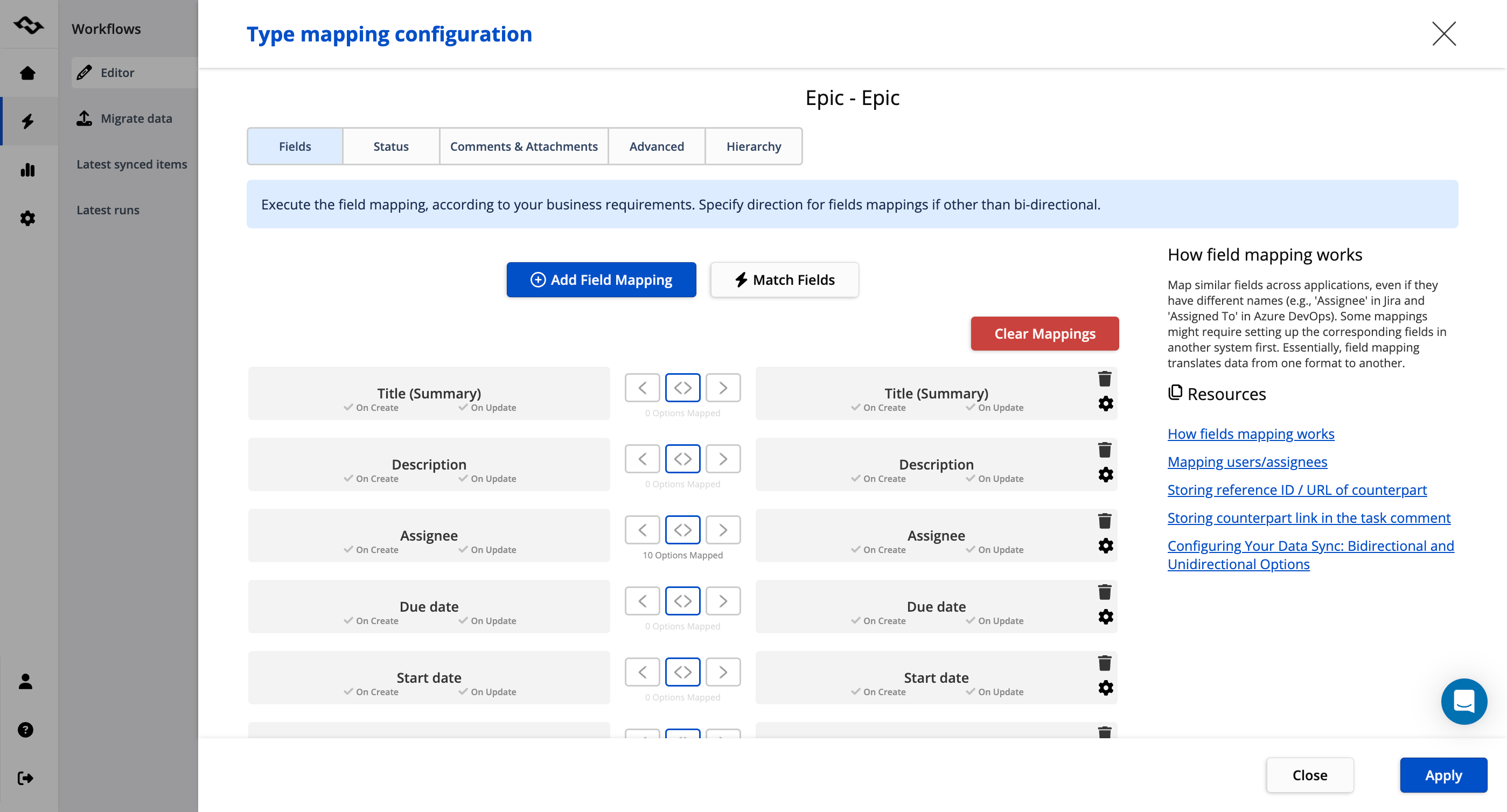
Step 8:
Test the integration by creating a new task in one Jira instance and ensuring it syncs correctly with the other.
Key Takeaways:
• Backbone requires more manual setup and involves installing the app on both Jira instances, with additional steps for field mapping and configuration.
• Getint streamlines the process with fewer steps, and its QuickBuild feature automatically maps most fields, saving time and effort. There’s no need to install it on both Jira instances during the trial phase, which makes setup easier.
Features Breakdown: What Can Each Tool Do?
Both Backbone and Getint offer robust features for Jira-to-Jira integrations, but they differ significantly in flexibility and ease of use. Let’s dive into the most important features and see how the two platforms compare.
QuickBuild & Auto Mapping
Backbone:
Backbone provides basic auto-mapping for simple fields like text, dates, and labels. However, complex fields such as statuses and priorities require manual mapping, which can slow down the configuration process, especially for larger projects with custom fields.
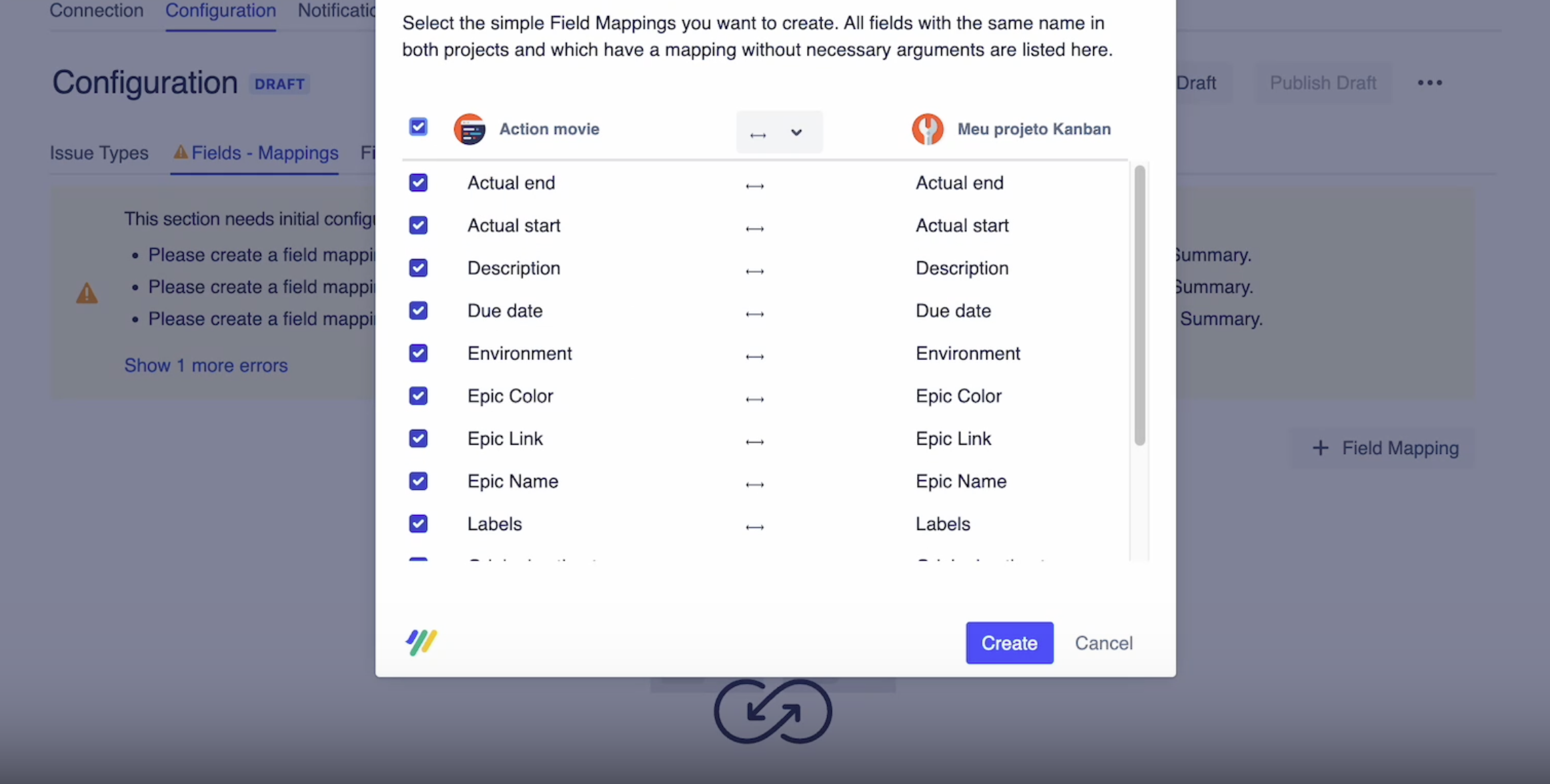
Getint:
Getint’s QuickBuild automatically maps both simple and complex fields, including statuses, priorities, and assignees. This reduces the need for manual configuration, saving time during the setup process. It’s ideal for larger projects and more complex integrations.
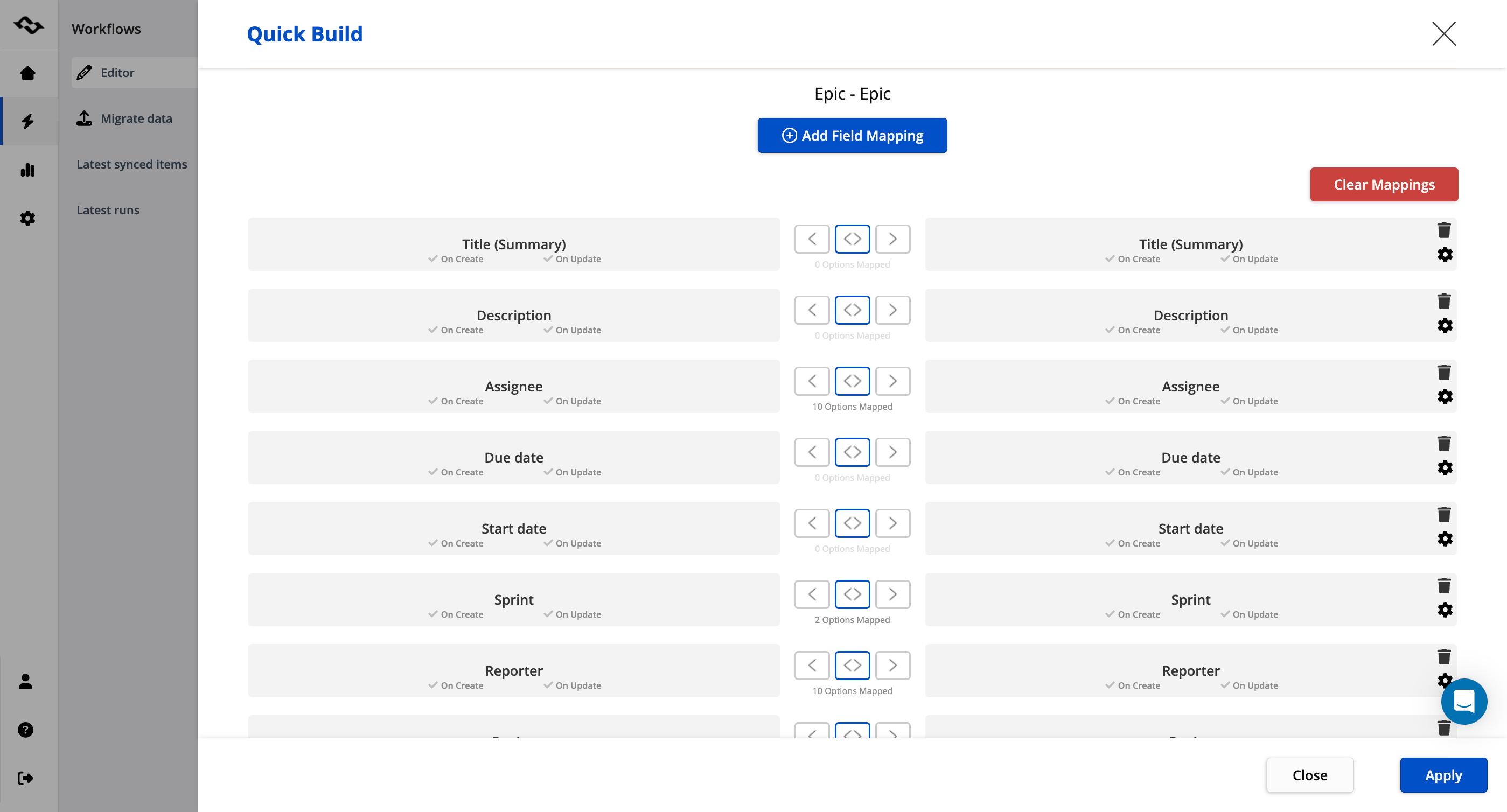
Syncing Comments & Attachments
Backbone:
By default, Backbone syncs comments under the generic account “Backbone Issue Sync” without providing any information about the original author. However, this setup can be adjusted to include the original author, date, and time in the comment’s footer, but it’s not enabled by default. Attachments also require manual configuration to sync.

Getint:
Getint automatically adds information about the original author, date, and time to synced comments, providing greater transparency. This is enabled by default. Attachments sync automatically, without requiring additional steps from the user, making the process smoother and less manual.
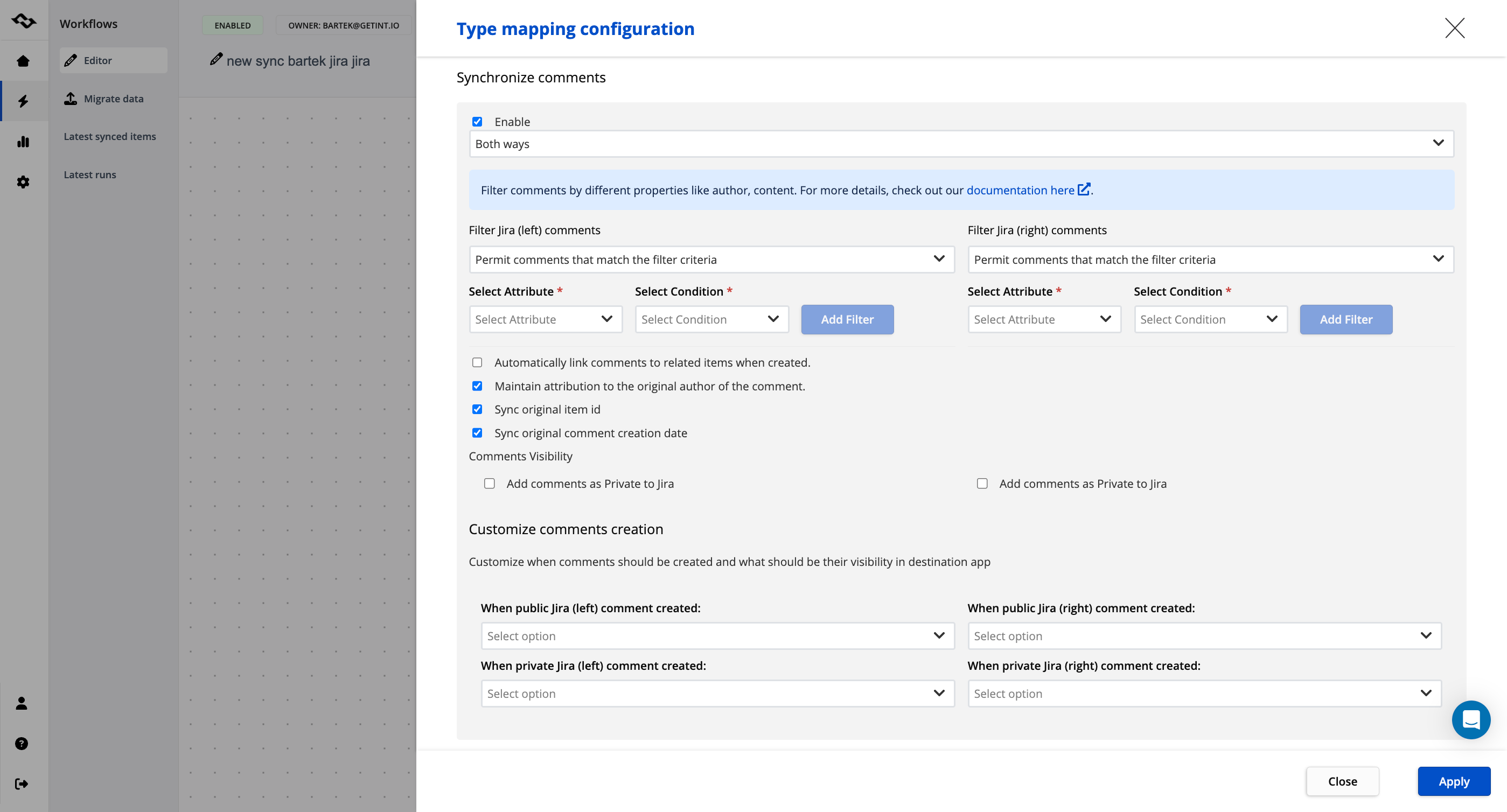
Filtering
Backbone:
Backbone relies solely on JQL (Jira Query Language) for filtering, which can be powerful for advanced users familiar with the syntax. However, for non-technical users, this can be a limitation, as JQL requires some learning to use effectively.
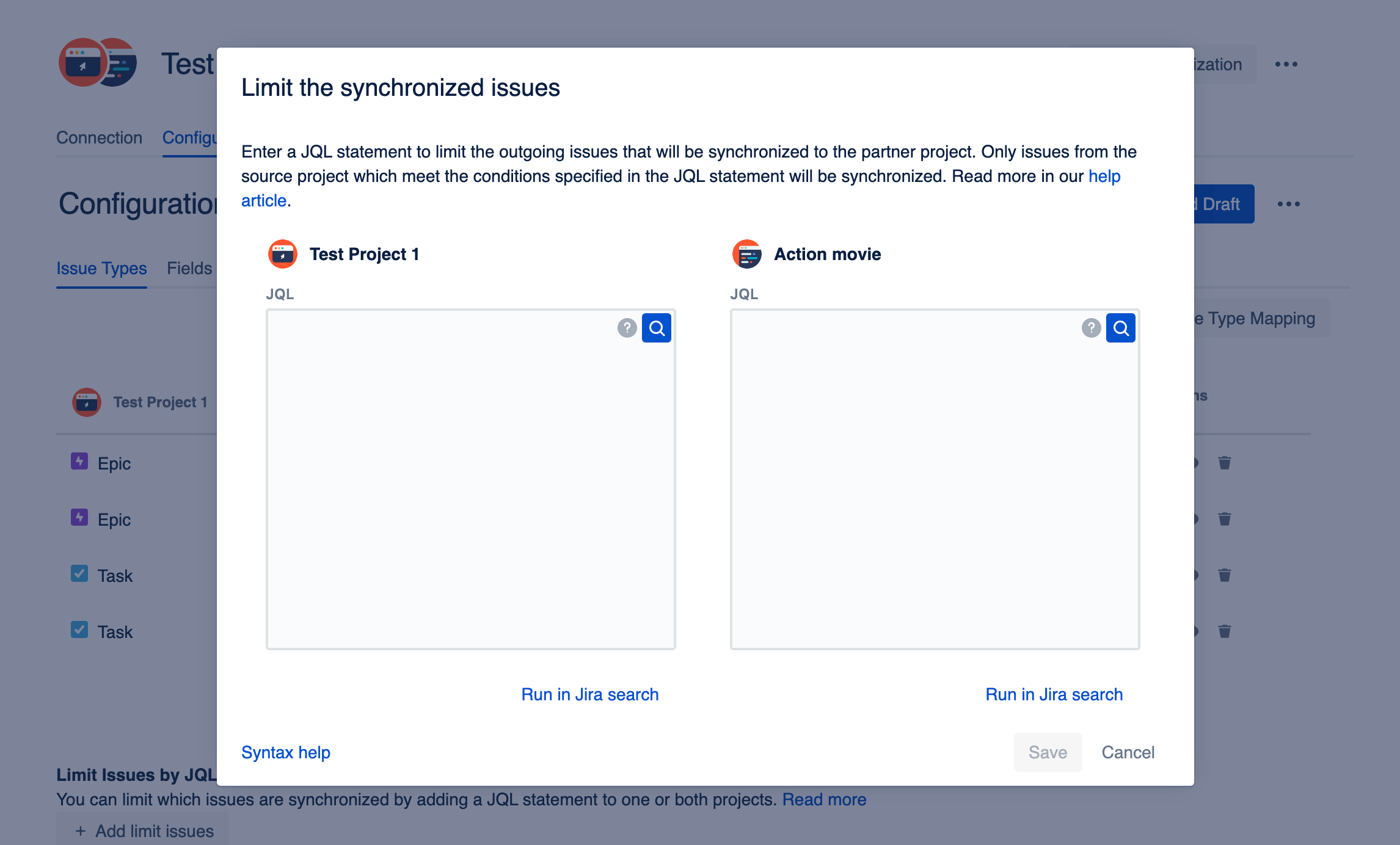
Getint:
Getint offers more flexibility in filtering. You can either use JQL, like in Backbone, or opt for a user-friendly, UI-based filtering system that utilizes dropdown menus. This makes filtering more accessible to both technical and non-technical users, offering greater control over what data gets synced.


Scripting
Backbone:
Backbone does not support custom scripting. This can limit its use in more complex workflows where businesses need to add custom logic or handle special cases.
Getint:
Getint supports custom scripting, allowing users to create advanced workflows and define specific business logic. This makes Getint much more adaptable for companies that need specialized sync processes or more granular control over how their data is handled.
Unidirectional & Bidirectional Sync Support
Backbone:
Both unidirectional (one-way) and bidirectional (two-way) syncs are supported in Backbone, but switching between the two options requires navigating back through multiple configuration steps, which can be time-consuming.
Getint:
Getint allows for seamless switching between unidirectional and bidirectional sync, not just for entire projects but for each issue type and field individually. This provides total flexibility, allowing users to customize sync directions for every aspect of the integration without limitations or extra configuration steps.
Historical Data Sync (Migration)
Backbone:
By default, Backbone syncs all historical data. While this is acceptable for smaller projects, it can become a burden for larger datasets, as there’s no option to sync a specific date range or select individual task IDs for migration.
Getint:
Getint gives users control over historical data syncing. You can choose to sync specific tasks, items within a certain date range, or based on criteria like task status or type. This flexibility allows for more efficient data migration and sync management.
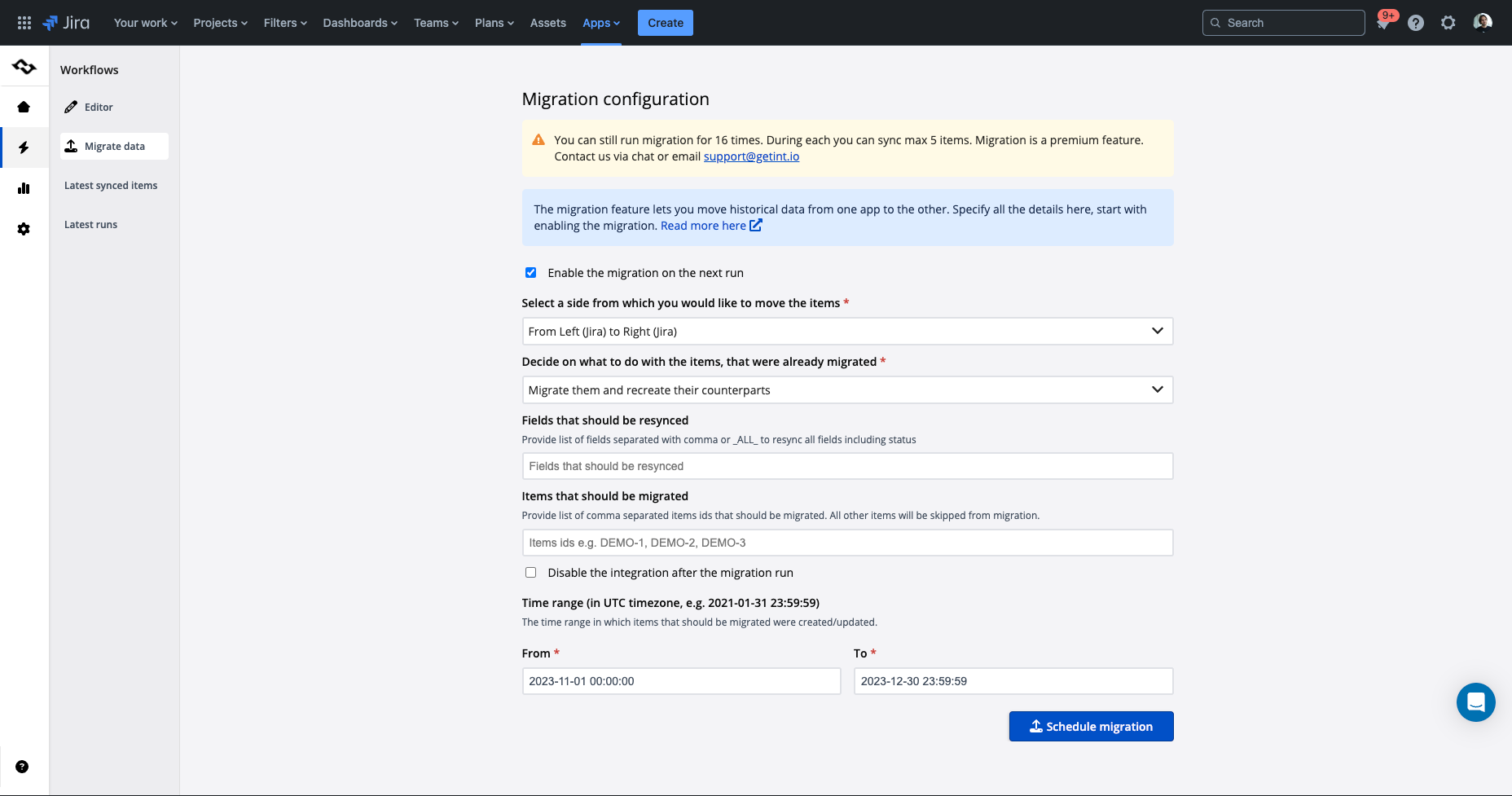
Key Takeaways:
• Auto Mapping: Getint automatically maps complex fields, while Backbone requires manual configuration for fields like statuses and priorities.
• Comments & Attachments: Getint provides more transparency by adding author details automatically, while Backbone requires manual setup for this.
• Filtering: Getint offers both JQL and a simple UI for filtering, while Backbone is limited to JQL.
• Scripting: Getint supports custom scripting, allowing advanced workflows, while Backbone lacks this capability.
• Sync Directions: Getint provides more flexibility by allowing users to set unidirectional or bidirectional sync for each type and field, whereas Backbone requires more cumbersome reconfiguration.
Reporting: How Transparent is Your Data?
Backbone and Getint take different approaches when it comes to reporting, particularly in how they present and manage integration data for users and administrators.
Backbone: Basic Issue-Level Reporting
Backbone integrates a side panel within Jira’s UI, which allows users to see basic sync data directly from within a Jira work item. This side panel gives end users a quick view of key integration information, such as the sync status and related fields. However, Backbone lacks a centralized reporting dashboard within its app UI.
Without central reporting, administrators can’t easily monitor or investigate sync issues across multiple integrations, projects, or instances. This limitation makes it more challenging to gain a holistic view of integration performance and troubleshoot effectively.
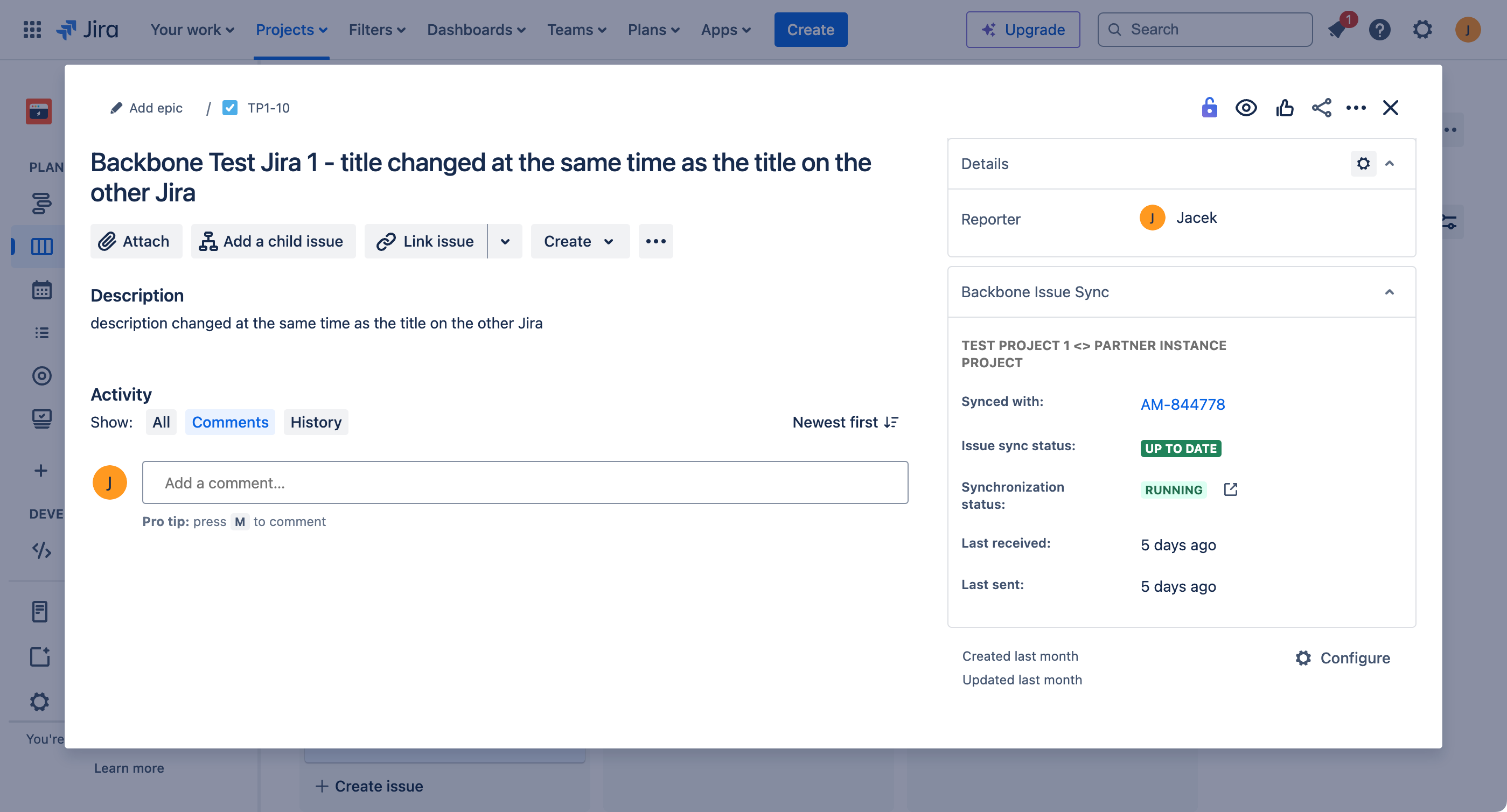
Getint: Centralized Reporting with Detailed Logs
Getint provides a comprehensive and more robust approach to reporting. Instead of embedding reports in individual Jira work items, Getint offers a dedicated reporting section within its app UI. This centralized dashboard allows administrators to access detailed information about all ongoing integrations, across all projects and issues.
One of Getint’s standout features is the availability of detailed error descriptions. Logs are updated close to real-time, providing transparency into sync statuses, error causes, and specific field mappings. Additionally, these logs can be encrypted, ensuring that sensitive data remains secure while being accessible for troubleshooting and audit purposes.
Admins can quickly identify recurring issues, track sync performance across platforms, and easily manage multiple integrations. Getint also integrates with third-party monitoring tools like DataDog and Dynatrace for teams that require more advanced tracking capabilities.
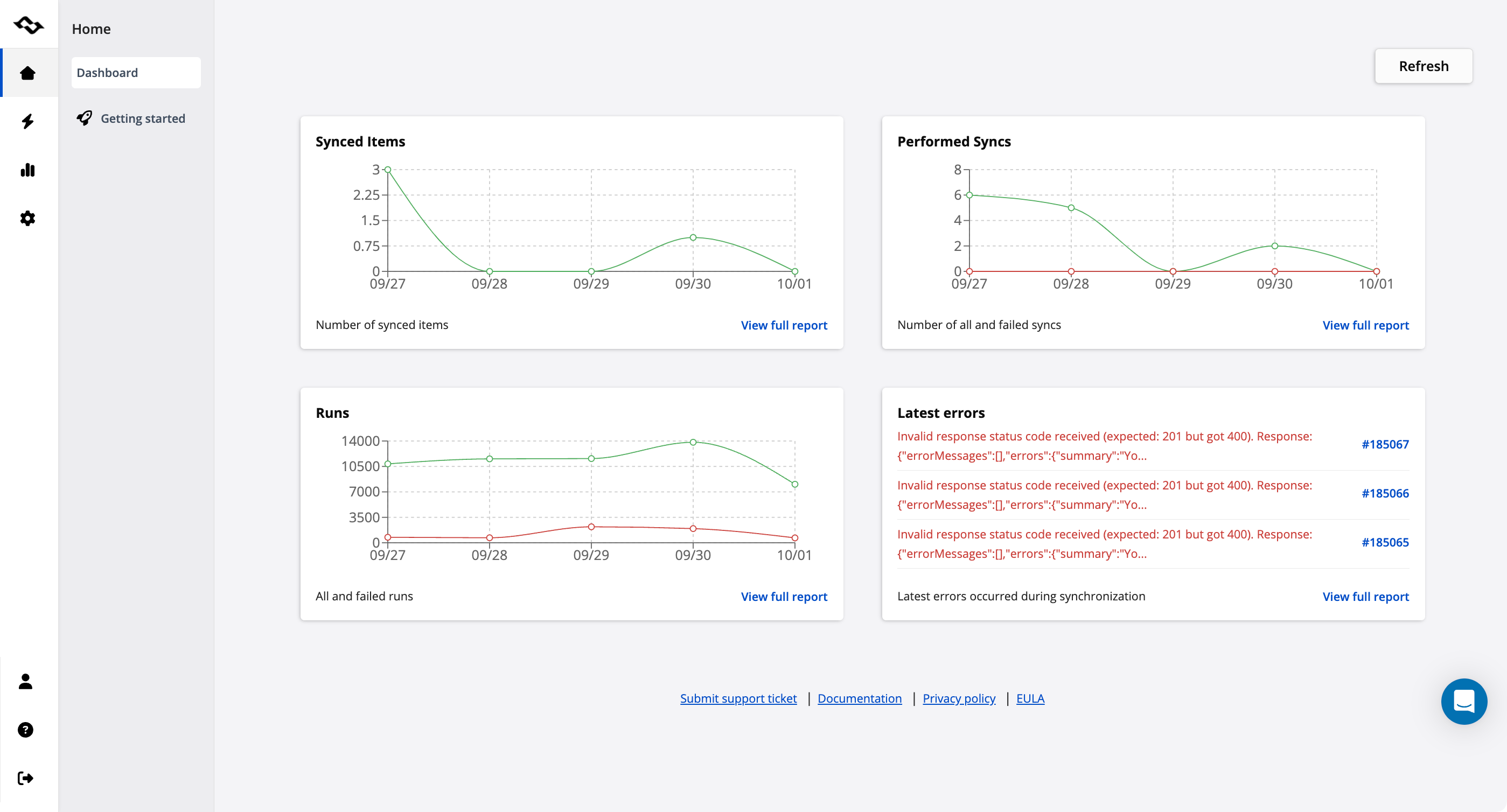
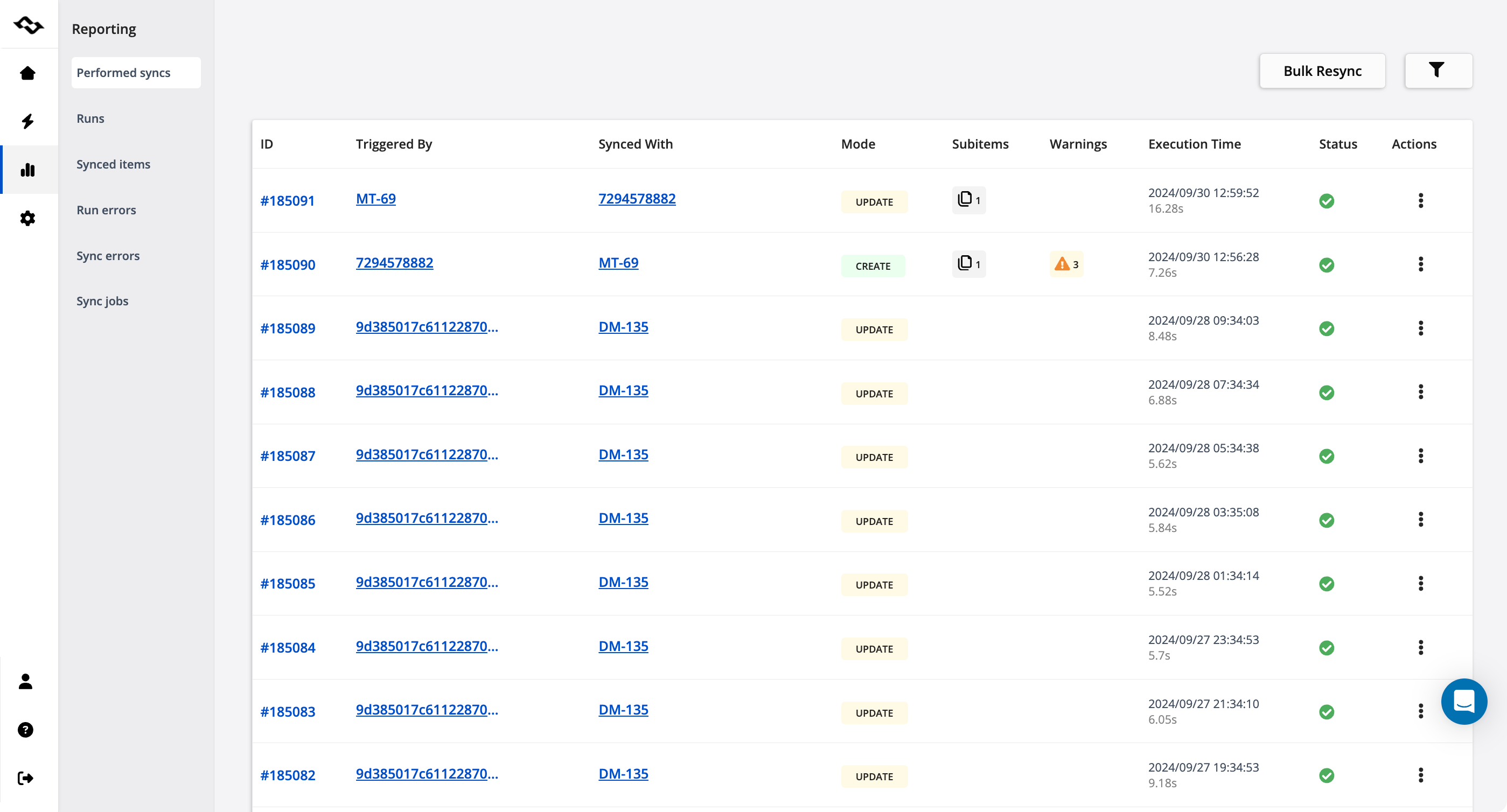

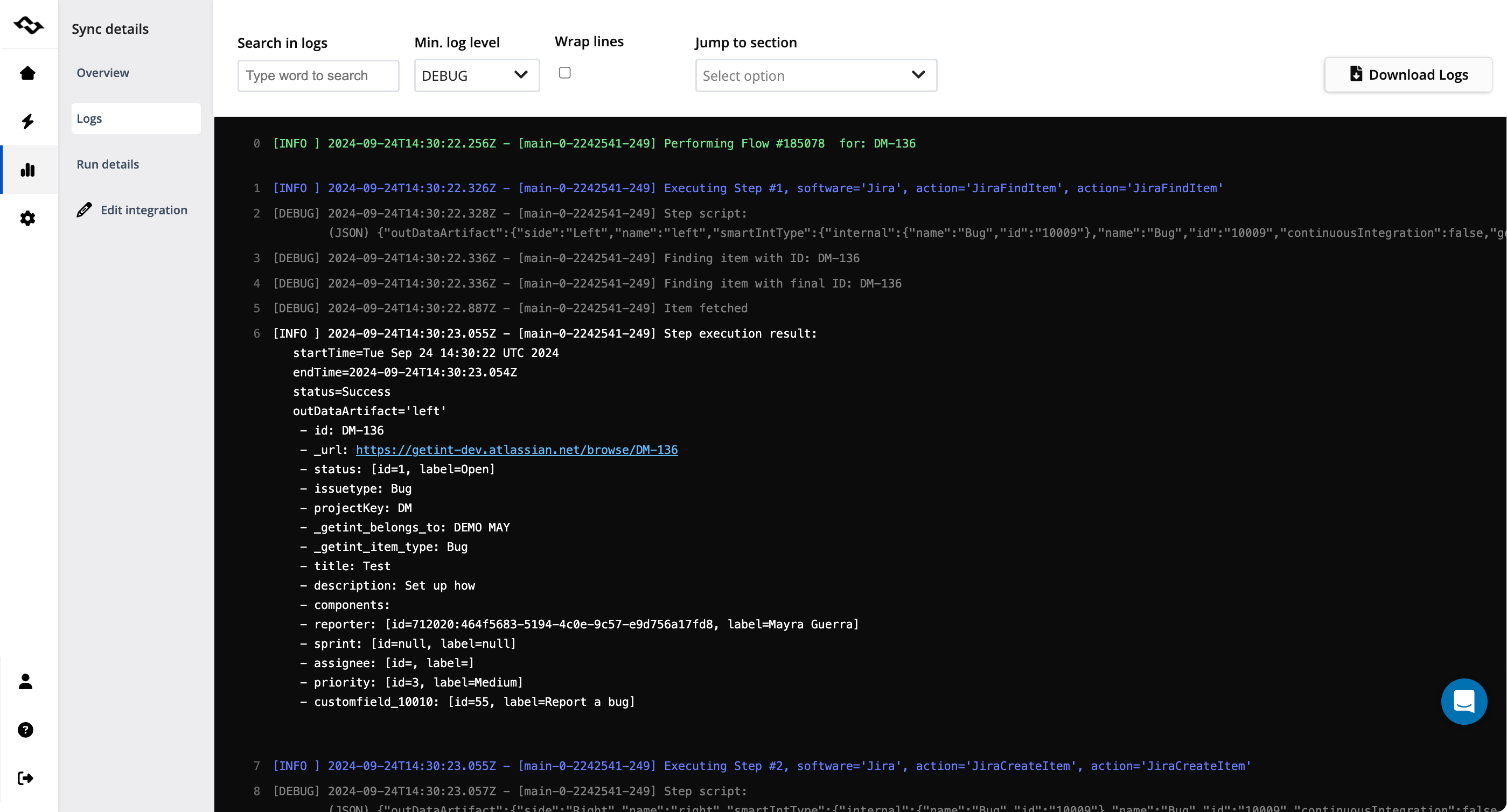
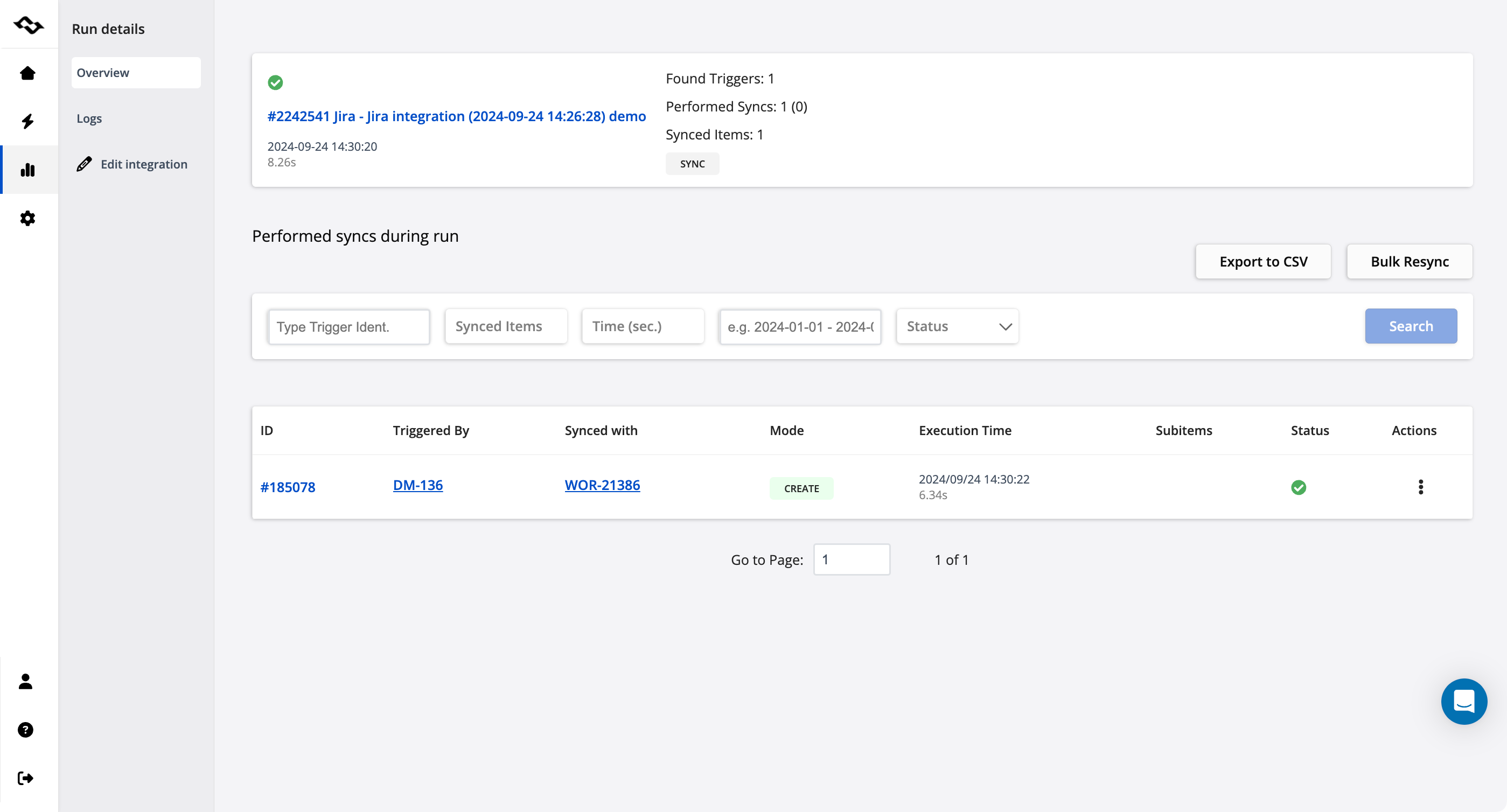
Key Differences in Reporting:
• Backbone: Reporting is handled at the issue level via a side panel in Jira, providing basic data visibility for end users. However, it lacks centralized reporting and detailed error logs for admin oversight.
• Getint: Offers a centralized reporting dashboard within its app UI, providing admins with detailed logs (that can be encrypted), close to real-time error reporting, and descriptions. It’s designed for greater transparency and control over multiple integrations.
Pricing Comparison: Which Option Offers Better Value?
Pricing is an important factor when choosing an integration tool, and while both Backbone and Getint offer remote licenses, their models differ in flexibility and service options. Here’s a breakdown of how each platform structures its pricing and the value they provide.
Backbone: Pricing Across Jira Types
Backbone’s pricing is based on the number of Jira users, and it requires installation on both Jira instances being integrated. Whether you’re using Jira Cloud, Server, or Data Center, the pricing model remains the same.
Backbone offers a remote license, but it is limited to Jira Server or Data Center. This restriction can be a blocker for companies using Jira Cloud for integrations, as it requires the Jira instance where Backbone is configured to be a Server or Data Center instance.
Getint: Flexible Pricing with More Integration Options
Getint also structures its pricing based on Jira users but offers more flexibility. It supports any Jira type—Cloud, Server, or Data Center—without the need for installation on both instances, thanks to its remote license option.
Additionally, Getint allows you to integrate other platforms like Azure DevOps, ServiceNow, and Salesforce by adding extra licenses. This makes it a scalable solution for organizations needing to manage integrations across multiple platforms.
OnPremise Solution: Getint also offers an OnPremise version that can work fully behind a firewall for deals starting at $5,000 USD and up, catering to companies with strict security requirements.
Onboarding, Support, and Custom Development
When it comes to support, the differences between the two platforms become more apparent. Backbone does not explicitly advertise onboarding, premium support, or custom development services, though it’s possible these services could be offered by K15t, the company behind Backbone. However, there’s no clear information available, so this remains an assumption.
Getint, by contrast, offers onboarding, premium support, and custom development options for an additional fee. This ensures that teams can get expert help during setup and ongoing assistance or custom features as needed.
Key Differences in Pricing:
• Backbone: Offers remote licenses limited to Jira Server or Data Center, and while onboarding and premium support may be available through K15t, there is no clear information provided.
• Getint: Provides remote licenses for all Jira types, integrates with other platforms through additional licenses, and offers onboarding, premium support, and custom development for an extra fee, making it a more versatile option for complex setups.
Which Offers Better Value?
For companies managing multiple Jira environments or integrating with other platforms, Getint offers more flexibility and value. Its support for all Jira environments, ability to integrate with external tools, and premium support options make it a more comprehensive solution for organizations with complex integration needs. Backbone, while effective for basic Jira-to-Jira syncs, may lack the flexibility and support services required for larger, more demanding projects.
Notifications & Error Handling: Stay Informed
When integrating multiple systems, it’s essential to stay informed about the status of your syncs, especially when issues arise. Here’s how Backbone and Getint handle notifications and error management.
Backbone: Basic Notifications
Backbone provides basic email notifications that alert you when something goes wrong with your integration. The platform automatically retries failed syncs, but it doesn’t offer much visibility into what caused the sync to fail or what is being retried. This lack of transparency can make troubleshooting more difficult.

Getint: Detailed Alerts & Transparent Logs
Getint offers a more comprehensive notification system. In addition to email alerts, you can receive in-app notifications, integrate with Slack, and set up webhooks to link with third-party monitoring tools like DataDog or Dynatrace. This ensures teams are kept up-to-date on integration statuses in real-time, wherever they work.
For error handling, Getint automatically retries failed syncs and offers detailed error descriptions along with logs that can be encrypted. These logs provide insight into what caused the issue, and admins have more control over manually resyncing specific fields if necessary. Logs are updated close to real-time, making issue resolution quicker and more efficient.


Security & Compliance: Certifications That Matter
When dealing with sensitive data, security and compliance are non-negotiable. Both Backbone and Getint ensure compliance with key regulations, but Getint offers more extensive certifications and controls.
Backbone: Basic Compliance with Regional Options
Backbone complies with ISO 27001, ensuring that its data security processes meet internationally recognized standards. It is also GDPR-compliant, ensuring that personal data is handled properly under European regulations. Backbone offers some flexibility with data residency, allowing users to choose between hosting their data in the EU or the USA.
Getint: Advanced Certifications and Global Flexibility
Getint meets ISO 27001 and GDPR requirements and extends its compliance to ISO 27018, which focuses on protecting personal data in cloud environments. Additionally, SOC 2 certification is expected by 2025, further enhancing Getint’s appeal for enterprises with strict data security requirements.
Getint also offers flexibility in data residency, allowing companies to choose data centers in specific countries, such as India, beyond just the EU or USA. This global flexibility can be crucial for companies that need to comply with local regulations in specific regions.
Marketplace Security Programs
Both Backbone and Getint participate in Atlassian’s Bug Bounty and Cloud Fortified programs, which help ensure the ongoing security and reliability of their apps through regular vulnerability testing.
Enterprise Features: What Big Companies Need
Large enterprises require tools that scale and adapt to their complex integration needs. Getint and Backbone cater to enterprise clients in different ways, but Getint provides more versatility.
Backbone: Limited Enterprise Features
Backbone is well-suited for straightforward Jira-to-Jira integrations, and it offers some enterprise-level features, such as the ability to operate behind the firewall. It also provides data residency options, letting you choose between hosting data in the EU or USA. However, Backbone lacks advanced features like centralized reporting and custom development options, which can be a limitation for organizations with complex needs.
Getint: Enterprise-Ready with Advanced Features
Getint is designed to cater to enterprise-level needs with a variety of features:
• Deployment Options: Getint can operate as a Jira App or as a standalone product (either SaaS or OnPremise), offering flexibility for different operational models.
• Folders: To manage complex integrations, Getint provides the ability to organize multiple integrations into folders, making it easier to manage large-scale projects across various departments.
• Data Residency: Getint offers flexibility beyond the typical EU or USA options, allowing companies to host their data in specific countries, like India, to meet local regulatory requirements.
• Custom Development and Onboarding: For enterprises with unique requirements, Getint offers custom development and onboarding services, ensuring that the platform can be tailored to fit specific business needs and that teams receive the support they need during setup.
Support & Documentation: How Helpful Are They?
When it comes to integration platforms, having reliable support and clear documentation can make a significant difference in your daily operations. Let’s see how Backbone and Getint compare.
Backbone: Basic Support, with Some Uncertainty
Backbone offers standard support through email and its help center. While the documentation is well-organized and provides step-by-step instructions for setting up basic and advanced use cases, it lacks depth when dealing with complex troubleshooting or edge cases. Additionally, there’s no built-in chat feature for immediate assistance.
It’s possible that onboarding and premium support could be purchased through K15t (the company behind Backbone), but there is no clear information available, so this remains speculative. Custom development is also not offered, which can limit Backbone’s ability to handle unique or advanced use cases.
Getint: Multichannel, Responsive Support
Getint excels in customer support. It offers multiple channels, including chat, a support portal, and email. For companies looking for real-time assistance, Getint even provides a Slack channel where users can interact with the support team directly. This level of access ensures faster, more responsive support when issues arise.
Getint’s documentation is equally impressive. It’s divided into sections for quickstart guides and more in-depth technical guides for complex configurations. Additionally, Getint uses AI-powered documentation, allowing users to quickly find relevant answers to specific questions.
For more complex projects, Getint also offers onboarding and premium support packages, ensuring customers have expert assistance when integrating across platforms. Custom development services are available for those who need tailored solutions for their unique integration needs.
Data Migrations: Smooth Transitions
Migrating data between platforms or between different instances of the same tool can be a tricky process, especially when dealing with large datasets. Both Backbone and Getint offer data migration features, but Getint provides more control and flexibility.
Backbone: Limited Control Over Data Migrations
Backbone supports initial syncs, which can function as basic data migrations, but it has limitations. Users cannot specify a date range or select specific task IDs to migrate, meaning all historical data is synced by default. This lack of filtering can be problematic for teams looking to migrate only a subset of their data.
Additionally, Backbone does not offer an archiving feature, so there’s no way to move old records out of active projects for future reference. While this works for simple data migration needs, it falls short when dealing with complex, large-scale transitions.
Getint: Granular Control and Archiving
Getint offers far more control over data migrations. Users can select specific fields, data types, and values to be migrated, and also define time ranges, allowing for precise filtering of data. This ensures that only relevant information is migrated, reducing the load and complexity.
Moreover, Getint has a built-in Archiver feature that allows users to move and preview older tasks, making it easier to manage historical data without cluttering active projects. Whether transitioning between tools or migrating data between instances of Jira, Getint’s approach is tailored for more complex migration scenarios.
Public Use Cases & Reviews: What Customers Say
Hearing from real users can provide valuable insights into how well a platform works in practice. Here’s how Backbone and Getint compare when it comes to public use cases and customer reviews.
Getint: Case Studies from Well-Known Brands
Getint frequently publishes case studies, showcasing its platform in action across various industries. Well-known brands like Airbus, Lufthansa, Volkswagen (Skoda), Deloitte, and Capgemini have shared detailed use cases, demonstrating how Getint helped them streamline complex integrations across platforms like Jira, Azure DevOps, and ServiceNow. These case studies often include specific metrics and customer testimonials, offering a clear picture of how Getint performs in real-world scenarios.
For example:
• Lufthansa used Getint to manage Jira-DevOps integrations.
• Airbus leveraged Getint for Jira-ServiceNow syncing.
• Skoda Auto streamlined its Jira-DevOps workflows using Getint.
Each case study provides concrete examples of the challenges faced, the solutions implemented, and the measurable benefits realized.
Backbone: No Public Case Studies
Backbone does not offer any publicly available case studies or detailed user reviews. While the platform has a solid reputation and more than 2,800 installations on the Atlassian Marketplace, there are no in-depth, publicly shared stories from users or organizations about how they’ve benefited from using Backbone. This lack of public use cases makes it harder for potential customers to evaluate its effectiveness in complex integration scenarios.

Conclusion: Why Getint is the Better Choice for Jira-to-Jira Work Item Sync
When deciding on a platform for Jira-to-Jira work item sync, it’s important to select a tool that offers both simplicity and scalability. While both Backbone and Getint are designed for this purpose, Getint stands out, even for straightforward syncs.
Why Choose Getint for Jira-to-Jira Work Item Sync?
• Easy Setup: For even the simplest Jira-to-Jira work item sync, Getint’s intuitive interface and QuickBuild feature allow you to set up basic integrations in minutes. You don’t need to be a technical expert to get things up and running.
• Flexibility: While Backbone may handle basic syncs, Getint’s ability to switch between unidirectional and bidirectional sync for each field or issue type gives you flexibility without complexity. This means you can start simple and grow your integration as your needs evolve.
• Superior Error Handling and Reporting: Getint provides real-time notifications, detailed logs, and encrypted error descriptions, ensuring that even small issues are easy to identify and resolve. Backbone’s basic notifications don’t offer the same level of insight.
• Seamless Future-Proofing: Even if your Jira-to-Jira work item sync starts small, Getint is built to scale. As your organization grows or if you need to integrate other platforms like Azure DevOps or ServiceNow, Getint makes it easy to expand without switching tools.
• Advanced Support Options: Getint provides onboarding, premium support, and custom development—services that Backbone doesn’t clearly offer. This ensures you’ll always have the help you need, no matter the complexity of your integration.
Why Getint Works for Both Simple and Complex Syncs
Whether you’re syncing basic tasks between two Jira instances or managing complex workflows across multiple projects, Getint is the ideal solution. It offers the flexibility to start simple but is powerful enough to handle more advanced use cases when needed. With better reporting, error handling, and support, Getint ensures you’re prepared for any integration challenge.
In short, Getint isn’t just a tool for complex cases—it’s the smarter choice for any Jira-to-Jira work item sync, no matter how simple or complex your needs are
Q&A: Backbone vs. Getint for Jira-to-Jira Work Item Sync
What’s the best tool for Jira-to-Jira work item sync?
It depends on your needs. If you’re looking for a simple solution for basic Jira-to-Jira syncs, Backbone might be sufficient. However, if you need a more flexible tool that supports custom integrations, advanced reporting, and other platforms like Azure DevOps or ServiceNow, Getint is a better choice.
How does Backbone handle Jira-to-Jira work item sync?
Backbone is designed for Jira-to-Jira work item syncs. It allows you to sync issues across Jira Cloud, Server, and Data Center. However, it requires installation on both Jira instances and lacks advanced filtering or customization options. Backbone’s reporting is also limited to a side panel within individual Jira work items, without a centralized view for admins.
What makes Getint better for Jira-to-Jira work item sync?
Getint offers more advanced features for Jira-to-Jira work item sync, including automatic field mapping, flexible sync direction (unidirectional or bidirectional), and more granular control over what data gets synced. Additionally, Getint’s centralized reporting gives admins a clear view of all integrations, making it easier to monitor syncs across multiple Jira projects.
Can both Backbone and Getint handle complex Jira-to-Jira work item sync use cases?
Backbone is best for simple, straightforward syncs between Jira instances, but it lacks the flexibility needed for complex cases. Getint excels in complex Jira-to-Jira work item sync scenarios by providing custom development options, advanced filtering, and the ability to integrate with other platforms, giving you more control over the sync process.
What about error handling in Jira-to-Jira work item sync?
Backbone provides basic email notifications and automatically retries failed syncs but lacks detailed error reporting. Getint offers detailed logs (which can be encrypted) and close-to-real-time error notifications, giving you more insight into what went wrong during a Jira-to-Jira work item sync and how to fix it.
Do both tools support data residency for Jira-to-Jira work item sync?
Yes, both tools support data residency options. Backbone allows you to choose between EU and USA data centers, while Getint offers more flexibility by allowing you to host data in specific countries like India, ensuring compliance with local regulations for your Jira-to-Jira work item sync.
Which tool offers better support for Jira-to-Jira work item sync?
Getint offers better support. It provides chat, email, a Slack channel, and premium support for an extra fee. Backbone’s support is more limited to email, though onboarding and premium support might be available from its parent company, K15t, but this is not clearly advertised.
What’s the pricing difference between Backbone and Getint for Jira-to-Jira work item sync?
Both Backbone and Getint offer pricing based on the number of Jira users, but Getint provides more flexibility, especially with remote licenses that work across Jira Cloud, Server, and Data Center. Backbone’s remote licenses are restricted to Jira Server and Data Center. Getint also allows for integration with other platforms like Azure DevOps by purchasing additional licenses.
Can I integrate more than just Jira with these tools?
While Backbone focuses solely on Jira-to-Jira work item sync, Getint offers the ability to sync Jira with other platforms like Azure DevOps, ServiceNow, and Salesforce. This makes Getint a better choice for teams working across multiple tools.
How do I know which tool is right for my Jira-to-Jira work item sync?
If you need a simple tool for basic Jira-to-Jira work item sync, Backbone is a solid choice. However, if you require more advanced features, flexibility, and the ability to manage complex integrations, Getint is the more robust solution. It offers better support, customization options, and scalability.
Disclaimer:
The information provided in this article is based on tests conducted by our team, available public documentation, customer feedback, and third-party sources. We strive to ensure accuracy and fairness, but we cannot guarantee that all details are fully up to date or reflective of the most recent changes in the products mentioned.
This comparison is meant for informational purposes only and reflects our personal experiences and evaluations. We encourage readers to conduct their own research and contact the respective companies for the most accurate and up-to-date information. All trademarks, product names, and company names mentioned are the property of their respective owners.
–
The comparisons and insights provided in this article are based on our own analysis, hands-on testing, feedback from customers and partners, and publicly available information as of September 30, 2024. While we’ve made every effort to ensure the accuracy and fairness of this comparison between Getint and Backbone, we recognize that tools and features can evolve over time.
If any information is outdated or inaccurately presented, we welcome your feedback and will gladly review and make corrections as needed. Our goal is to provide the most helpful and accurate resource possible for teams evaluating integration solutions.

